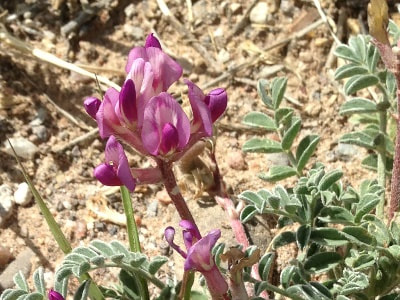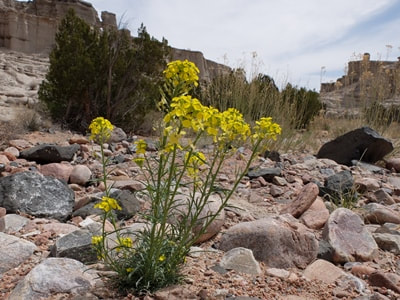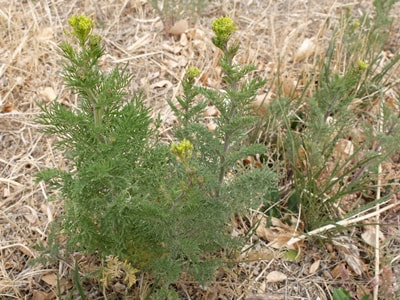|
Found in disturbed soil, fields, roadsides
Seen blooming in May outside San Juan School, Ohkay Owingeh Whitetop grows to two feet tall in dense clumps with stout stems. Leaves are grayish-green and clasp the stems, basal leaves wither at flowering. Numerous tiny white flowers with four petals grow in flat-topped clusters two inches across. Seeds are heart-shaped. Whitetop is a very invasive species that spreads from its roots as well as by seeds, a single plant can produce 1,200 to 4,800 seeds. It is considered a noxious weed in New Mexico and many other states. As one of its common names, Wild Broccoli, implies, it is an edible plant. The edible parts are the young leaves and immature flower tops, which look like tiny florets of broccoli. Like many plants in the mustard family, they have a spicy hot-mustard flavor. Seeds are used as a pepper substitute. Medicinally, Whitetop has been used for preventing scurvy and as a bitter spring tonic. Source. If you trying to identify a different flower then you can check what other flowers bloom this month. If you cannot identify a flower from the website, send a photo and where you took it to [email protected]. Read online for tips.
0 Comments
Found in dry, sandy, piñon-juniper woodlands, roadsides
Seen blooming in May at Abiquiu Lake and USPS Española There are more than 75 species of Astragalus in New Mexico, many with similarly colored pea-like flowers. The seed pods are often the best way to identify them, as is the case with the Crescent Milkvetch. It grows to about one foot high with grayish, arching leaflets. The stems and leaflets are covered in dense silvery hairs. Flowers grow in a cluster at the top of the stalk and are pink/purple, up to 1¼ inch long. Seed pods are about 1 inch long, slightly hairy and curved, crescent-shaped. Traditionally, a Zuni medicine man chewed a fresh or dried root before sucking out a snakebite and applied a poultice to the wound. Source. This is National Wildflower Week. You may find this article from the World Wildlife Fund inspirational. Join the SuperBloom and get free seeds. All we need is rain! If you trying to identify a different flower then you can check what other flowers bloom this month. If you cannot identify a flower from the website, send a photo and where you took it to [email protected]. Read online for tips. Found on sandy slopes and rocky ridges
Seen blooming in April on the north rim of Cañon de Cobre Townsend Daisies are commonly called Easter Daisies because they bloom early in the season, often around Easter time. Several species can be found in our area. They grow low to the ground in cushions with flowers nestled low among the leaves, sometimes covering them. The Slender-leaf Townsend Daisy has leaves that are slightly hairy, long, narrow and grayish. The large, eye-catching flowers are white or pinkish, and are about one inch across. Traditionally, Townsend Daisies were chewed or an infusion was taken to ease delivery of a baby, dried plants were used as snuff to clear the throat, a decoction of the roots was given to tired horses, and the plant was used ceremonially. Source. If you trying to identify a different flower then you can check what other flowers bloom this month. If you cannot identify a flower from the website, send a photo and where you took it to [email protected]. Read online for tips. Found in sandy, rocky soil from the desert to alpine meadows
Seen blooming in April in Plaza Blanca The Wallflower is a common and widespread species. It earned its common name by growing on stone walls in Europe. It grows from a few inches to 30" high with a dense cluster of flowers on an erect stem. Flowers are most typically bright golden yellow but plants in some populations may have tangerine-colored, pink or purple flowers. Each flower has four flat petals and is more than ½ inch across. Seed pods are up to 4 inches long and grow upright, parallel to the stem. In Greek, Erysimum translates as “to help or save” in reference to the medicinal qualities of several species. Practitioners of European folk medicine used wallflower poultices to relieve bronchial congestion, as did Native Americans, who also used dried leaves or seeds to make a tea for stomach cramps and ground the flowers to make yellow paint. Wallflowers are also important sources of food for wildlife, including the caterpillars of a number of butterfly and moth species. Source. If you trying to identify a different flower then you can check what other flowers bloom this month. If you cannot identify a flower from the website, send a photo and where you took it to [email protected]. Read online for tips. Found in disturbed soil, roadsides, sandy areas
Seen in April on CR 142 If you saw this in your yard, you would pull it as a weed, but Herb Sophia has many beneficial properties. It grows from 6 to 30 inches high with a single erect stem, branching in the upper plant as flower stalks grow. Leaves are bright green and feathery, divided into numerous narrow segments. Flattish clusters of flowers bloom at the tip of the branches. Flowers are tiny, about 1/8 inch across, with four yellow petals. Seed pods are one inch long, narrow and point upwards. Native Americans have used Herb Sophia for both food and medicinal purposes. Young leaves and shoots can be boiled and eaten as greens. The seed can be ground, mixed with cornmeal and used to make bread and cakes. Ground seeds were added to water to make a cooling drink or were mixed with snow and eaten as ice cream. Medicinally, a poultice of the plant has been used to ease toothache. The juice of the plant has been used in the treatment of chronic coughs, hoarseness, ulcerated sore throats and asthma. A poultice of ground seeds was used on burns and sores. It is used in the treatment of asthma, fevers, bronchitis, oedema, scurvy and dysentery and as a diuretic, expectorant, laxative, digestive aid and tonic, and in the treatment of worms. Leaves were buried with seed corn to prevent spoiling. Source. If you trying to identify a different flower then you can check what other flowers bloom this month. If you cannot identify a flower from the website, send a photo and where you took it to [email protected]. Read online for tips. |
AuthorI am Marilyn Phillips, a native of England, whose love of nature and the outdoors from childhood brought me by a circuitous route to Crested Butte, Colorado in 1993 and 16 years later to northern New Mexico. My exploration of the many trails in these areas, my interest in wildflowers and photography, and career in computer system design came together in this creation. If you have any corrections, comments or questions, please contact me by email. Archives
September 2025
Categoriescopyright © 2020
|







 RSS Feed
RSS Feed